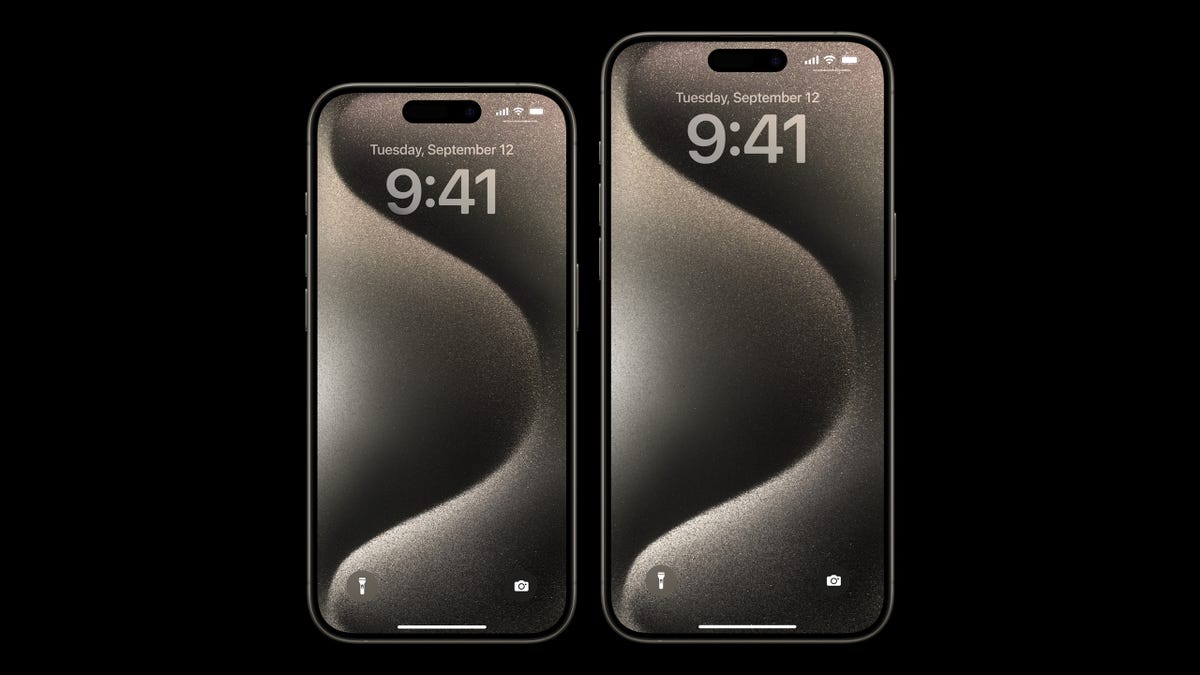Everything You Need to Know About the IPhone 15 Pro and 15 Pro Max

The iPhone 15 lineup is officially unveiled. Apple has updated all of its new iPhones across the board, adding Dynamic Island to the standard iPhone 15 and 15 Plus and upgrading their main camera to 48 megapixels. But that doesn’t mean the iPhone 15 Pro and 15 Pro Max are left behind: the more expensive iPhones come with plenty of exclusive features that are worth highlighting.
Display and design
While all the new iPhones have great OLED displays, it’s the professionals who get the best of the bunch. Both the 15 Pro and 15 Pro Max feature large OLED displays with a dynamic island at the top: this space houses the front-facing camera and sensors, as well as space for app data and interactions. These displays have a 120Hz refresh rate, which makes everything much smoother.
The iPhone 15 Pro has a 6.1-inch display, while the iPhone 15 Pro Max has a 6.7-inch display. These dimensions have not changed compared to last year, so at first glance the phones may not look different from others. But look closer and you’ll notice that the edges of the phones are slightly thinner.
These iPhones are now made from titanium rather than stainless steel. Apple touts the material’s strength and durability, as well as its lightness. There’s also a new matte finish. For the first time, Apple has made these phones more repairable. How repairable it is is still a question for reviewers, but any step in that direction is a good step.
A17 Pro
Apple is extending Pro branding to its SoCs. The A17 Pro is Apple’s latest iPhone chip and, as expected, boasts a performance boost over last year’s A16 Bionic (found in the iPhone 14 Pro and standard iPhone 15). It is the industry’s first 3nm chip with 19 billion transistors, a six-core processor (two high-performance and four high-efficiency), a 16-core neural processor and a six-core “pro-grade” GPU. This iPhone is the first to support hardware ray tracing, a graphics process that can more accurately reflect in-game lighting conditions.
Cameras
The iPhone 15 Pro and 15 Pro Max feature a triple camera setup, as we expected. But this year, the iPhone 15 Pro Max introduces a new type of camera: Apple replaces the traditional “telephoto” camera with a periscope camera that offers 5x zoom capabilities at a 120mm focal length and ƒ/2.8 aperture. By comparison, the 15 Pro’s telephoto lens can shoot at 3x magnification at a focal length of 77mm. The camera also has an improved stabilizer that helps avoid shake when using long focal lengths.
Other than that big change, the cameras are similar to last year’s 14 Pro and 14 Pro Max. The main camera is still 48MP, but has a larger sensor than last year, with a 24mm focal length and ƒ/1.78 aperture. You can now shoot with the main camera at three different focal lengths: 24mm, 28mm and 35mm. Ultra Wide shoots in macro mode at a focal length of 13 mm and an aperture of ƒ/2.2. Considering all the cameras and lenses, Apple calls it “seven lenses in your pocket.”
The company is also touting new portraits across the entire iPhone 15 lineup, which should result in improved color and bokeh. iOS automatically captures the details needed for portraits, so you don’t have to switch to portrait mode to take a photo. Exciting news: The Camera app now has focus and depth control, features previously only available in professional camera apps.
On the video side, you can now shoot “Spatial Video,” a type of 3D video that you’ll be able to view with the upcoming Apple Vision Pro. It is also the first iPhone to support the “Academic Color Coding System”.
Action button
Rumors have been circulating for the past year that this iPhone will be the first to do away with the classic mute switch in favor of a new “action button.” The Action button has a lot of benefits: While you can still use it as a mute switch by pressing and holding the button, you can also decide to have it launch a voice memo, raise the camera, toggle a shortcut, and more.
USB-C
The main news this year for all iPhone 15 models was Apple’s transition to USB-C. The Lightning port that Apple has been using since 2012 is gone, finally replaced by the port you’re likely to find on most of your technology these days.
Apple didn’t add USB-C to its iPhones because it thought it was time; rather, the EU forced the company to do so through recent legislation .
While all iPhone 15 models feature USB-C, the iPhone Pros have faster speeds and support USB 3 speeds of up to 10 Gbps.
Connectivity
Pros now come with Wi-Fi 6E, an improvement over Wi-Fi 6. The new technology delivers higher throughput, faster speeds, and lower latency. It also features a next-generation ultra-wideband chip that makes it easier to find devices and friends using the Find My app.
Apple uses Emergency SOS technology to let you send text messages to roadside assistance when you need it. When you buy an iPhone 15 device, you get these satellite features free for two years. (No information on pricing yet.)
Cost and release date
The iPhone 15 Pro retains the standard “Pro” price, starting at $999 for 128GB of storage, while the iPhone 15 Pro Max increases the base price by $100, with the 15 Pro Max now starting at $1,199 for 256GB of storage.
You can pre-order the iPhone 15 Pro and 15 Pro Max starting at 5 a.m. PT on Friday, September 15th, and they’ll be available starting Friday, September 22nd.